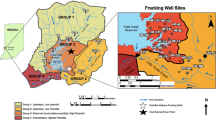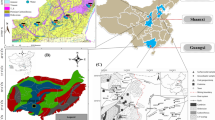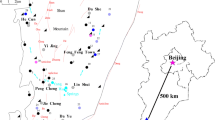Abstract
The organic composition of groundwater along the Carrizo-Wilcox aquifer in East Texas (USA), sampled from rural wells in May and September 2015, was examined as part of a larger study of the potential health and environmental effects of organic compounds derived from low-rank coals. The quality of water from the low-rank coal-bearing Carrizo-Wilcox aquifer is a potential environmental concern and no detailed studies of the organic compounds in this aquifer have been published. Organic compounds identified in the water samples included: aliphatics and their fatty acid derivatives, phenols, biphenyls, N-, O-, and S-containing heterocyclic compounds, polycyclic aromatic hydrocarbons (PAHs), aromatic amines, and phthalates. Many of the identified organic compounds (aliphatics, phenols, heterocyclic compounds, PAHs) are geogenic and originated from groundwater leaching of young and unmetamorphosed low-rank coals. Estimated concentrations of individual compounds ranged from about 3.9 to 0.01 μg/L. In many rural areas in East Texas, coal strata provide aquifers for drinking water wells. Organic compounds observed in groundwater are likely to be present in drinking water supplied from wells that penetrate the coal. Some of the organic compounds identified in the water samples are potentially toxic to humans, but at the estimated levels in these samples, the compounds are unlikely to cause acute health problems. The human health effects of low-level chronic exposure to coal-derived organic compounds in drinking water in East Texas are currently unknown, and continuing studies will evaluate possible toxicity.
Résumé
La composition organique des eaux souterraines de l’aquifère de Carrizo-Wilcox dans l’est du Texas (EU), échantillonnée sur des puits ruraux de mai à septembre 2015, a été analysée dans le cadre d’une étude plus large sur les effets possibles sur la santé et l’environnement des composés organiques dérivés des formations houillères de basse qualité. La qualité de l’eau de l’aquifère de Carrizo-Wilcox riche en charbon de basse qualité est un problème environnemental possible et il n’existe pas d’études détaillées publiées sur les composés organiques de cet aquifère. Les composés organiques analysés dans les échantillons d’eau comprennent : aliphatiques et leurs dérivés d’acides gras, phénols, biphényles, composés hétérocycliques contenant N-, O- et S-, hydrocarbures aromatiques polycycliques (HAP), amines aromatiques et phtalates. Beaucoup de composés organiques identifiés (aliphatiques, phénols, composés hétérocycliques, HAP) sont géogéniques et proviennent du lessivage de jeunes formations houillères de basse qualité et non métamorphisées. Les concentrations estimées des composés individuels varient de 3.9 à 0.01 μg/L. Dans de nombreuses régions rurales de l’Est du Texas, les couches de charbon composent les aquifères captées pour l’alimentation en eau potable. Les composés organiques observés dans les eaux souterraines sont susceptibles d’être présents dans l’eau potable provenant de forages interceptant les niveaux de charbon. Quelques composés organiques identifiés dans les échantillons d’eau sont potentiellement toxiques pour l’homme mais, aux concentrations retrouvées dans les échantillons, ces composés n’entrainent probablement pas de problème notable sur la santé. Les effets sur la santé humaine d’une exposition chronique à de faibles concentrations des composés organiques dérivés du charbon présents dans l’eau potable dans l’Est du Texas ne sont pas connus actuellement, et les études qui se poursuivent évalueront leur toxicité éventuelle.
Resumen
Se examina la composición orgánica del agua subterránea a lo largo del acuífero Carrizo-Wilcox del Este de Texas (EEUU), muestreado a partir de pozos rurales en mayo y septiembre de 2015, como parte de un gran estudio sobre los efectos potenciales al ambiente y la salud de los compuestos orgánicos derivados de carbones de bajo grado. La calidad del agua a partir del acuífero Carrizo-Wilcox que contiene el carbón de bajo grado es una preocupación ambiental potencial y no se publicó ningún estudio detallado de compuestos orgánicos en este acuífero. Los componentes orgánicos identificados en las muestras de agua subterránea incluyeron: alifáticos y sus derivados de ácidos grasos, fenoles, bifenilos, compuestos heterocíclicos que contienen N-, O-, y S-, hidrocarburos aromáticos policíclicos (HAP), aminas aromáticas y ftalatos. Muchos de los compuestos orgánicos identificados (alifáticos, fenoles, compuestos heterocíclicos, HAP) son geogénicos y se originan de la lixiviación de las capas subterráneas de carbón joven de bajo grado y no metamorfoseado. Las concentraciones estimadas de los compuestos individuales oscilaron entre aproximadamente 3.9 y 0.01 μg/L. En muchas zonas rurales del este de Texas, los estratos de carbón aportan acuíferos para los pozos de agua potable. Es probable que los compuestos orgánicos observados en el agua subterránea estén presentes en el agua potable de los pozos que penetran en el carbón. Algunos de los compuestos orgánicos identificados en las muestras de agua son potencialmente tóxicos para los seres humanos, pero en los niveles estimados en estas muestras son poco probables que causen problemas agudos de salud. Los efectos sobre la salud humana de la exposición crónica de bajo nivel a compuestos orgánicos derivados del carbón en el agua potable en el este de Texas son actualmente desconocidos y continuando los estudios se evaluará la posible toxicidad.
摘要
2015年5月和9月从农村井中对(美国)德克萨斯州东部沿Carrizo-Wilcox含水层所采的有机成分样品进行了分析,这项工作是劣质煤中有机化合物潜在健康和环境影响研究项目的一部分。含劣质煤的Carrizo-Wilcox含水层中的水质是潜在的环境问题,有关这个含水层有机化合物详细研究的成果还没有发表过。水样中确认的有机化合物包括:脂肪族化合物及其脂肪酸派生物、酚类化合物、联苯、N-、 O-、含S的杂环化合物、多环芳烃、芳香胺和邻苯二甲酸盐。许多确认的有机化合物(脂肪族化合物、酚类化合物、杂环化合物和多环芳烃)是地球成因的,来源于年轻的及未变质劣质煤中的地下水淋滤。每种化合物的估测浓度大约为3.9 到 0.01 μg/L。在德克萨斯州东部许多农村地区,煤层充当着饮用水井的含水层。地下水中观测到的有机化合物很可能存在于煤层井提供的饮用水中。水样中确认的有些化合物可能对人类有毒,但是根据这些样品中估测的含量水平,其化合物不可能引起严重的健康问题。低水平长期接触德克萨斯州东部源自煤的饮用水中的化合物对人类健康影响目前还是未知,后续研究将评估可能的毒性。
Resumo
A composição orgânica das águas subterrâneas do aquífero Carrizo-Wilcox, amostradas em poços cacimba em East Texas (EUA) entre maio e setembro de 2015, foi examinada como parte de um estudo mais amplo sobre os potenciais efeitos à saúde e ao meio ambiente dos compostos orgânicos derivados de carvões de baixo grau de carbonificação. A qualidade da água oriunda dos carvões de baixo grau de carbonificação do aquífero Carrizo-Wilcox é uma potencial preocupação ambiental e estudos detalhados sobre os compostos orgânicos não têm sido publicados. Os compostos orgânicos identificados nas águas incluem: alifáticos e derivados oleosos ácidos; fenóis; bifenilas; compostos heterocíclicos do tipo N-, O-, e S-; hidrocarbonetos aromáticos policíclicos (HAPs), aminas aromáticas; e ftalatos. Muitos dos compostos orgânicos identificados (alifáticos, fenóis, compostos heterocíclicos, HAPs) são geogênicos e originados pela lixiviação de carvões de baixo grau de carbonificação não metamorfisados e juvenis nas águas subterrâneas. As concentrações estimadas de cada composto variaram entre aproximadamente 3.9 e 0.01 μg/L. Em várias áreas rurais de East Texas, a camada de carvão fornece água aos aquíferos explotados por poços de abastecimento. Os compostos observados na água subterrânea provavelmente estão presentes na água explotada pelos poços que interceptam a camada de carvão. Alguns dos compostos orgânicos identificados em amostras de água são potencialmente tóxicos à saúde humana, entretanto, nas concentrações estimadas nessas amostras, esses compostos provavelmente não devem causar problemas agudos á saúde. Os efeitos à saúde humana causados pela exposição crônica aos baixos níveis dos compostos orgânicos derivados do carvão nas águas subterrâneas ainda são desconhecidos, de modo que estudos futuros avaliarão os possíveis níveis de toxicidade.


Similar content being viewed by others
References
Albaigés J, Algaba J, Clavell E et al (1986) Petroleum geochemistry of the Tarragona Basin (Spanish Mediterranean off-shore). Org Geochem 10:441–450
Baird WM, Hooven LA, Mahadevan B (2005) Carcinogenic polycyclic aromatic hydrocarbon‐DNA adducts and mechanism of action. Environ Mol Mutagen 45:106–114
Baker EL, Landrigan PJ, Bertozzi PE et al (1978) Phenol poisoning due to contaminated drinking water. Arch Environ Health 33:89–94
Bechtel A, Sachsenhofer RF, Kolcon I et al (2002) Organic geochemistry of the Lower Miocene Oberdorf lignite (Styrian Basin, Austria): its relation to petrography, palynology and the palaeoenvironment. Int J Coal Geol 51:31–57
Bendoraitis J (1974) Hydrocarbons of biogenic origin in petroleum-aromatic triterpenes and bicyclic sesquiterpenes. In: Advances in organic geochemistry 1973. Technip, Paris, pp 209–224
Blum P, Sagner A, Tiehm A et al (2011) Importance of heterocylic aromatic compounds in monitored natural attenuation for coal tar contaminated aquifers: a review. J Contam Hydrol 126:181–194
Boutwell RK, Bosch DK (1959) The tumor-promoting action of phenol and related compounds for mouse skin. Cancer Res 19:413–424
Božić Z, Duančić V, Belicza M et al (1995) Balkan endemic nephropathy: still a mysterious disease. Eur J Epidemiol 11:235–238
Bruce RM, Santodonato J, Neal MW (1987) Summary review of the health effects associated with phenol. Toxicol Ind Health 3:535–568
Bunnell JE, Tatu CA, Bushon RN et al (2006) Possible linkages between lignite aquifers, pathogenic microbes, and renal pelvic cancer in northwestern Louisiana, USA. Environ Geochem Health 28:577–587
Census Bureau U (2010) State and county quick facts. Retrieved May 8, 2010, from U.S. Census Bureau, Washington, DC. https://www.census.gov/geo/reference/ua/urban-rural-2010.html
Čeović S, Hrabar A, Šarić M (1992) Epidemiology of Balkan endemic nephropathy. Food Chem Toxicol 30:183–188
Egashira R, Nagai M, Salim C (2000) Separation of nitrogen heterocyclic compounds contained in coal tar absorption oil fraction by solvent extraction. Sekiyu Gakkaishi 43:339–345
Feder GL, Tatu CA, Orem WH, Paunescu V, Dumitrascu V, Szilagyi DN, Finkelman RB, Margineanu F, Schneider F (2002) Weathered coal deposits and Balkan endemic nephropathy. Facta Univ 9(1):34–38
Filho PJS, Nogueira VRP, Krause LC et al (2002) Polycyclic aromatic hydrocarbons from Candiota (South Brazilian) coal extracts. Polycycl Aromat Compd 22:13–22
Finkelman RB (2007) Health impacts of coal: facts and fallacies. Ambio 36:103–106
Finkelman RB, Orem W, Castranova V et al (2002) Health impacts of coal and coal use: possible solutions. Int J Coal Geol 50:425–443
Goldberg MC, Feder GL, Radovanovic Z (1994) Correlation of Balkan endemic nephropathy with fluorescent organic compounds in shallow groundwater. Appl Hydrogeol 2:15–22
Grimalt J, Albaigés J, Alexander G et al (1986) Predominance of even carbon-numbered n-alkanes in coal seam samples of Nograd Basin (Hungary). Naturwissenschaften 73:729–731
Handbook of Texas Online (2016) Dwight F. Henderson and Diana J. Kleiner, Coal and Lignite Mining. http://www.tshaonline.org/handbook/online/articles/dkc03. Accessed 20 Dec 2016
Iordanidis A, Schwarzbauer J, Georgakopoulos A et al (2012) Organic geochemistry of Amynteo lignite deposit, northern Greece: a multi-analytical approach. Geochem Int 50:159–178
Kaiser W (1974) Texas lignite: near-surface and deep-basin resources. The University of Texas at Austin, Bureau of Economic Geology Report of Investigations No. 79, 70 p
Kaiser WR, Ayers Jr W, LaBrie L (1980) Lignite resources in Texas. The University of Texas at Austin, Bureau of Economic Geology Report of Investigations No. 104, 52 p
Kapusta K, Stańczyk K (2011) Pollution of water during underground coal gasification of hard coal and lignite. Fuel 90:1927–1934
Liu J, Liu G, Zhang J et al (2012) Occurrence and risk assessment of polycyclic aromatic hydrocarbons in soil from the Tiefa coal mine district, Liaoning, China. J Environ Monit 14:2634–2642
Maharaj S, Orem W, Tatu C et al (2014) Organic compounds in water extracts of coal: links to Balkan endemic nephropathy. Environ Geochem Health 36:1–17
Marston CP, Pereira C, Ferguson J et al (2001) Effect of a complex environmental mixture from coal tar containing polycyclic aromatic hydrocarbons (PAH) on the tumor initiation, PAH-DNA binding and metabolic activation of carcinogenic PAH in mouse epidermis. Carcinogenesis 22:1077–1086
McElmurry SP, Voice TC (2004) Screening methodology for coal-derived organic contaminants in water. Int J Environ Anal Chem 84:277–287
Ontario Ministry of the Environment (1985) Review of benzo[a]pyrene: occurrence, human exposure and health effects. Canviro, Kitchener, ON
Orem WH, Finkelman RB (2004) Coal formation and geochemistry. In: Holland HD, Turekian KK (eds) Treatise on geochemistry, vol 7. Elsevier, Amsterdam, pp 191–222
Orem WH, Tatu CA (2001) Health effects of toxic organic compounds from coal: the case of Balkan endemic nephropathy (BEN). US Department of the Interior, US Geological Survey Fact Sheet 004-01 (https://pubs.usgs.gov/fs/fs004-01)
Orem WH, Feder GL, Finkelman RB (1999) A possible link between Balkan endemic nephropathy and the leaching of toxic organic compounds from Pliocene lignite by groundwater: preliminary investigation. Int J Coal Geol 40:237–252
Orem WH, Tatu CA, Feder GL et al (2002) Environment, geochemistry and the etiology of Balkan endemic nephropathy: lessons from Romania. Facta universitatis-series: Medicine and Biology 9:39–48
Orem WH, Tatu CA, Lerch H et al (2004) Identification and environmental significance of the organic compounds in water supplies associated with a Balkan endemic nephropathy region in Romania. J Environ Health Res 3(2). http://www.cieh.org/jehr/organic_compounds_endemic_nephropathy.html. Accessed December 2016
Orem WH, Tatu CA, Lerch HE et al (2007) Organic compounds in produced waters from coalbed natural gas wells in the Powder River Basin, Wyoming, USA. Appl Geochem 22:2240–2256
Orem W, Tatu C, Varonka M et al (2014) Organic substances in produced and formation water from unconventional natural gas extraction in coal and shale. Int J Coal Geol 126:20–31
Peterson M, Finkelman RB, Orem W et al (2009) Organic compounds in the Carrizo-Wilcox aquifer of East Texas and possible health implications. Geol Soc Am Abstr Programs 41:13
Philp RP, Gilbert TD, Friedrich J (1981) Bicyclic sesquiterpenoids and diterpenoids in Australian crude oils. Geochim Cosmochim Acta 45:1173–1180
Philp R, Simoneit B, Gilbert T (1983) Diterpenoids in crude oils and coals of South Eastern Australia. Adv Org Geochem 1981:698–704
Pleština R (1992) Some features of Balkan endemic nephropathy. Food Chem Toxicol 30:177–181
Ries L, Eisner M, Kosary C (2001) SEER cancer statistics, 1973–1998, vol 2. National Cancer Institute, Bethesda, MD, pp 1375–1382
Roland HL, Jenkins GM, Pope DE (1976) Lignite: evaluation of near-surface deposits in Northwest Louisiana. Dept. of Conservation, Louisiana Geological Survey, Baton Rouge, LA
Ryder P (1996) Ground water atlas of the United States, Oklahoma, Texas, HA 730-E. US Geological Survey, Reston
Schultz TW, Cajina-Quezada M, Dumont JN (1980) Structure-toxicity relationships of selected nitrogenous heterocyclic compounds. Arch Environ Contam Toxicol 9:591–598
Simoneit BR (1977) Diterpenoid compounds and other lipids in deep-sea sediments and their geochemical significance. Geochim Cosmochim Acta 41(4):463–476
Stefanova M, Magnier C, Velinova D (1995) Biomarker assemblage of some Miocene-aged Bulgarian lignite lithotypes. Org Geochem 23:1067–1084
Sun Y, Wang B, Lin M (1998) Maceral and geochemical characteristics of coal seam 1 and oil shale 1 in fault-controlled Huangxian Basin, China. Org Geochem 29:583–591
Tang N, Hattori T, Taga R et al (2005) Polycyclic aromatic hydrocarbons and nitropolycyclic aromatic hydrocarbons in urban air particulates and their relationship to emission sources in the Pan–Japan Sea countries. Atmos Environ 39:5817–5826
Tatu CA, Orem WH, Feder GL et al (2000) Balkan endemic nephropathy etiology: a link to the geological environment. Cent Eur J Occup Environ Med 6:138–150
Tatu CA, Orem WH, Maharaj SV et al (2003) Organic compounds derived from Pliocene lignite and the etiology of Balkan endemic nephropathy. In: Geology and health: closing the gap. Oxford University Press, New York, pp 159–162
Texas State Historical Association (1997) The handbook of Texas online. Texas State Historical Association, Austin, TX
Tully J (1996) Coal fields of the conterminous United States, US Geol Surv Open File Rep 96-092
Van Kooten GK, Short JW, Kolak JJ (2002) Low-maturity Kulthieth Formation coal: a possible source of polycyclic aromatic hydrocarbons in benthic sediment of the northern Gulf of Alaska. Environ Forensic 3:227–241
Venkatesan M, Ruth E, Kaplan I (1986) Terpenoid hydrocarbons in Hula peat: structure and origins. Geochim Cosmochim Acta 50:1133–1139
Wang X, Zhong N, Hu D et al (2009) Polycyclic aromatic hydrocarbon (PAHs) pollutants in groundwater from coal gangue stack area: characteristics and origin. Water Sci Technol 59:1043–1051
Warshawsky D, Cody T, Radike M et al (1995) Biotransformation of benzo [a] pyrene and other polycyclic aromatic hydrocarbons and heterocyclic analogs by several green algae and other algal species under gold and white light. Chem Biol Interact 97:131–148
Warwick PD, Aubourg C, Willett J (1999) Tertiary coals in South Texas; anomalous cannel-like coals of Webb County (Claiborne Group, Eocene) and lignites of Atascosa County (Jackson Group, Eocene); geologic setting, character, source-rock and coal-bed methane potential. US Dept. of the Interior, U.S. Geological Survey Open-File Report 99-301, 55 p
Xue W, Warshawsky D (2005) Metabolic activation of polycyclic and heterocyclic aromatic hydrocarbons and DNA damage: a review. Toxicol Appl Pharmacol 206:73–93
Acknowledgements
The field and the laboratory work for the research was supported by grants from the Geological Society of America and American Association of Petroleum Geologist (Chakraborty). Laboratory analyses of organic compounds at the USGS in Reston, Virginia, were supported by the USGS Energy Resources Program. Any use of trade, firm, or product names is for descriptive purposes only and does not imply endorsement by the US Government.
Author information
Authors and Affiliations
Corresponding author
Additional information
Published in the special issue “Hydrogeology and Human Health”
Rights and permissions
About this article
Cite this article
Chakraborty, J., Varonka, M., Orem, W. et al. Geogenic organic contaminants in the low-rank coal-bearing Carrizo-Wilcox aquifer of East Texas, USA. Hydrogeol J 25, 1219–1228 (2017). https://doi.org/10.1007/s10040-016-1508-6
Received:
Accepted:
Published:
Issue Date:
DOI: https://doi.org/10.1007/s10040-016-1508-6




